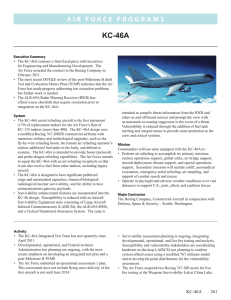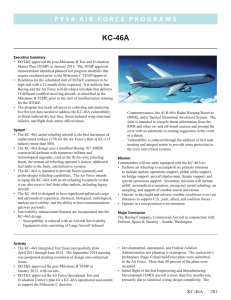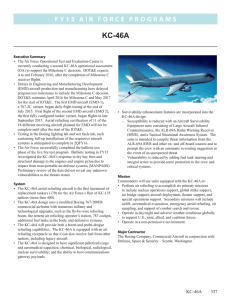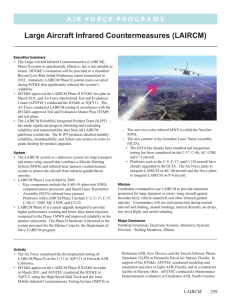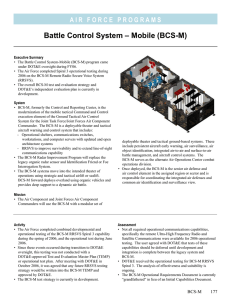KC-46A A i r F o r c e ...
advertisement
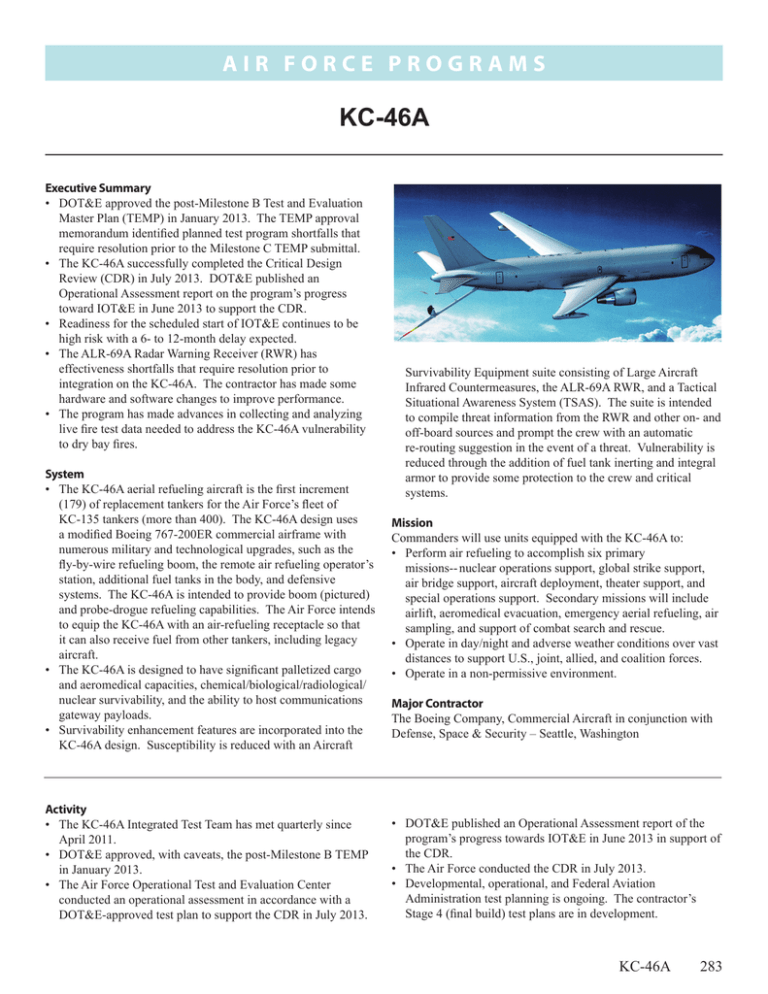
A i r F o r c e P RO G R A M S KC-46A Executive Summary • DOT&E approved the post-Milestone B Test and Evaluation Master Plan (TEMP) in January 2013. The TEMP approval memorandum identified planned test program shortfalls that require resolution prior to the Milestone C TEMP submittal. • The KC-46A successfully completed the Critical Design Review (CDR) in July 2013. DOT&E published an Operational Assessment report on the program’s progress toward IOT&E in June 2013 to support the CDR. • Readiness for the scheduled start of IOT&E continues to be high risk with a 6- to 12-month delay expected. • The ALR-69A Radar Warning Receiver (RWR) has effectiveness shortfalls that require resolution prior to integration on the KC-46A. The contractor has made some hardware and software changes to improve performance. • The program has made advances in collecting and analyzing live fire test data needed to address the KC-46A vulnerability to dry bay fires. System • The KC-46A aerial refueling aircraft is the first increment (179) of replacement tankers for the Air Force’s fleet of KC-135 tankers (more than 400). The KC-46A design uses a modified Boeing 767-200ER commercial airframe with numerous military and technological upgrades, such as the fly-by-wire refueling boom, the remote air refueling operator’s station, additional fuel tanks in the body, and defensive systems. The KC-46A is intended to provide boom (pictured) and probe-drogue refueling capabilities. The Air Force intends to equip the KC-46A with an air-refueling receptacle so that it can also receive fuel from other tankers, including legacy aircraft. • The KC-46A is designed to have significant palletized cargo and aeromedical capacities, chemical/biological/radiological/ nuclear survivability, and the ability to host communications gateway payloads. • Survivability enhancement features are incorporated into the KC-46A design. Susceptibility is reduced with an Aircraft Activity • The KC-46A Integrated Test Team has met quarterly since April 2011. • DOT&E approved, with caveats, the post-Milestone B TEMP in January 2013. • The Air Force Operational Test and Evaluation Center conducted an operational assessment in accordance with a DOT&E-approved test plan to support the CDR in July 2013. Survivability Equipment suite consisting of Large Aircraft Infrared Countermeasures, the ALR-69A RWR, and a Tactical Situational Awareness System (TSAS). The suite is intended to compile threat information from the RWR and other on- and off-board sources and prompt the crew with an automatic re-routing suggestion in the event of a threat. Vulnerability is reduced through the addition of fuel tank inerting and integral armor to provide some protection to the crew and critical systems. Mission Commanders will use units equipped with the KC-46A to: • Perform air refueling to accomplish six primary missions-- nuclear operations support, global strike support, air bridge support, aircraft deployment, theater support, and special operations support. Secondary missions will include airlift, aeromedical evacuation, emergency aerial refueling, air sampling, and support of combat search and rescue. • Operate in day/night and adverse weather conditions over vast distances to support U.S., joint, allied, and coalition forces. • Operate in a non-permissive environment. Major Contractor The Boeing Company, Commercial Aircraft in conjunction with Defense, Space & Security – Seattle, Washington • DOT&E published an Operational Assessment report of the program’s progress towards IOT&E in June 2013 in support of the CDR. • The Air Force conducted the CDR in July 2013. • Developmental, operational, and Federal Aviation Administration test planning is ongoing. The contractor’s Stage 4 (final build) test plans are in development. KC-46A 283 A i r F o r c e P RO G R A M S • The Air Force is developing a KC-46A Design Reference Mission document to provide operator-defined mission scenarios in projected theaters, which are required to adequately complete an operationally realistic survivability assessment. • The LFT&E Integrated Product Team provided a detailed description of planned survivability analyses but is still identifying the developmental and operational test data requirements for these analyses and model verification. • The Air Force completed most of the testing needed to address the aircraft’s vulnerability to dry bay fires. The Air Force finalized the center wing dry bay fire vulnerability test plan and scheduled testing for 1QFY14. The remaining relevant tests, i.e., wing dry bay fire sustainment and fuselage dry bay fire vulnerability, are scheduled for FY14 and FY15, respectively. Assessment • The TEMP approval memorandum identified planned test program shortfalls that require resolution prior to the Milestone C TEMP submittal to gain DOT&E approval. The TEMP requires increased detail in a number of areas. The planned test program includes the following shortfalls that the Air Force has partially addressed but still require complete resolution to gain DOT&E approval at Milestone C: - The Air Force should mitigate the impact of concurrent activities and planned flying hours for the Engineering and Manufacturing Development (EMD) program that place a high demand on limited aircraft and simulator resources. - The task loading across EMD test aircraft is unbalanced. - The operational test aircrew and maintenance personnel must have time to attain their training requirements and establish proficiency in their tasks before the start of IOT&E. - The technical order verification process must be completed before the start of IOT&E. - Sufficient calendar time must be allotted for correction of discrepancies and/or deficiencies discovered during developmental testing prior to the planned start of operational testing. • The Air Force is continuing to analyze existing schedule risks and potential mitigations. However, until the final detailed plans (referred to as Stage 4 test plans) are delivered, DOT&E will not have sufficient insight to determine if there are adequate mitigations to reduce the risk in the EMD test schedule. Delivery of approximately 375 Stage 4 test plans started in September 2013 and delivery is planned to be complete in March 2014. • DOT&E analysis of initial Boeing schedules with regard to aerial refueling certifications, aircraft and support equipment technical orders, and operator/maintainer training indicates that operational testing will likely slip at least 6 to 12 months. • Recent ALR-69A RWR operational testing on the C-130H revealed that it was not effective due to integration and 284 KC-46A performance problems. ALR-69A RWR is being provided as Contractor Furnished Equipment, and in addition to previously identified shortfalls, requires additional complex integration with TSAS. The contractor has made some hardware and software changes to ALR-69A, including antennas, wingtip inertia measuring units, and some software modifications, which have yet to be proven in testing. • Preliminary ALR-69A RWR effectiveness test plans, TSAS, and crew situational awareness test plans needed for the survivability analyses and assessment are not well defined. Current test planning events and proposed test facilities require changes and upgrades to test the KC-46A against operationally realistic threat systems, consistent with the KC-46A concept of operations. Boeing intends to finalize these test plans by March 2014. • The KC-46A survivability requirements focused on less likely threats and did not thoroughly consider all survivability enhancement alternatives. Preliminary analysis of the wing leading edge, wing trailing edge, and center wing dry bay fire live fire test data confirmed the vulnerability of the KC-46A to dry bay fires. A dry bay fire suppression system was not considered in the design, even though it could have reduced KC-46A vulnerability more effectively than cockpit armor (less weight) against more operationally realistic threats. • The TEMP and other test documents do not address detailed Information Assurance (IA) protect, detect, react, and restore requirements. The program has begun to address these problems by planning additional testing and crew IA training through the IA Working Group. Recommendations • Status of Previous Recommendations. The Air Force is addressing some of the FY12 recommendations to incorporate realistic assumptions in test plans; however, additional work is still needed. The Air Force should still: 1. Submit a TEMP with a realistic schedule mitigating the above mentioned shortfalls. 2. Provide an approach to correct the ALR-69A RWR shortfalls prior to integration on the KC-46A. 3. Plan to begin IOT&E at least 6 to 12 months later than the current TEMP indicates to allow for completion of developmental test and initial training. • FY13 Recommendations. The Air Force should: 1. Provide a comprehensive aerial refueling certification plan for the KC-46A including all EMD Phase 1 and 2 receivers. 2. Plan testing against realistic cybersecurity threats to identify vulnerabilities for correction. In addition, plan follow-on penetration testing to assess IA performance in terms of protect, detect, react, and restore functions. 3. Consider the integration of a dry bay fire suppression system with the potential to reduce aircraft and crew vulnerability against operationally realistic threats.
